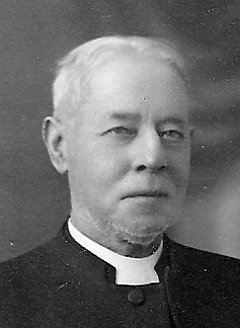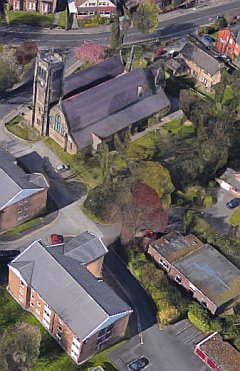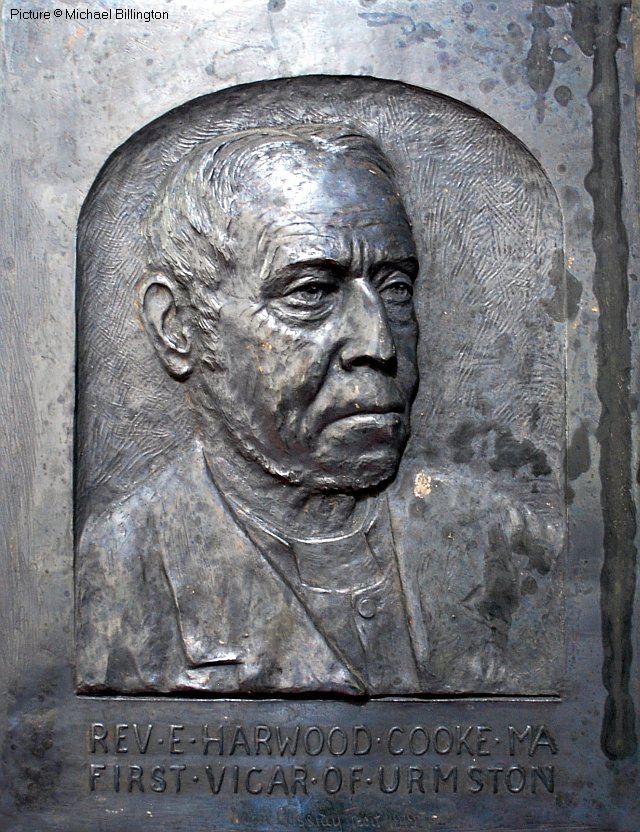
This feature owes its content to Michael Billington, author of the excellent book The Story of Urmston, Flixton and Davyhulme, published by History Press in 2018. Michael supplied us with a plethora of information and images He also photographed the work for us; it is mounted high on the sanctuary wall of St Clement's Church, needing help of a tall stepladder.

St Clement's Church

In the early 1800s, Urmston was a small farming village in the parish of Flixton; St Michael's Church in Flixton two miles from Urmston, was the Parish Church.
As Urmston grew, it needed its own Church, and in 1865 an acre of land, part of the Urmston Grange estate, was made available. The foundation stone was laid by the Bishop of Manchester, J. Prince Lee, on 16 March 1867; he returned on 4 January 1868 to consecrate the building and a thousand square yards of adjacent land adjacent to form a graveyard. the dedicatee St. Clement mentioned in the Epistle to the Philippians, Chapter 4, verse 3: 'And I intreat thee also, true yokefellow, help those women which laboured with me in the gospel, with Clement also, and with other my fellow labourers, whose names are in the book of life.'
Designed by J. Medland Taylor
in the decorated gothic style, and faced with york stone, the building initially housed housed 200 worshippers. An extension for a further 200 was opened in 1888, and followed in 1903 by the tower, which gained a clock in 1906.
It continues to flourish in 2019; details of its activities can be found on the Church website. The Rev. Cooke's vicarage, however, has disappeared, replaced by a row of modern houses - 'The Nook' - and a new vicarage stands next to the Church at 24 Stretford Road.
Website created and compiled by Charlie Hulme and Lis Nicholson, with the invaluable assistance of the John Cassidy Committee, Slane Historical Society.
Elijah Harwood Cooke MA, Urmston (1919)

This plaque, approximately 18 x 24 inches in size, is unusual in its patination, a grey pewter shade over what appears to be a bronze base. (It has suffered from damage at some time, due to a leak of some sort of liquid. It was created in 1919, a quiet time in Cassidy's career as the country recovered from the war, and he had only just begun design work on the war memorials which occupied him in the years to follow.

Cassidy signed the work in his usual way: 'John Cassidy fecit 1919.' Dates of birth and death are not included, as the subject was very much alive at the time. Tthe portrait might have been modelled from life, although it strongly resembles the photograph shown to the left. The commissioning of the plaque by the parishioners was, we assume, to commemorate the Rev. Cooke's 50 years in post as Vicar from 1868 to 1918.
Family History
Born on 31 October 1830 in Denton, near Manchester, Elijah Harwood Cooke was the son of William Cooke, a hatter, and his wife Margaret. In 1841 the couple was settled at 8 Church Street, in the nearby town of Hyde with their children Everett (aged 12), Elijah (10), Vera (8) and Hannah (4). By 1851 William had left the hatting trade and turned the Church Street house into a grocery shop; living there with the couple at that date were Everett (now a machinist) and Hannah, along with a son George (aged 18) who had not been listed in 1841. Elijah was working as a 'Journeyman Grocer' at 15 Portland Street, Manchester. Ten years later, William and Margaret were the only occupants of the grocery, but by 1871, returned from Wales and already Vicar of Urmston, Elijah was living with his father in the Hyde shop - perhaps the vicarage was not ready. Margaret had died by then, and Hannah had returned to act as housekeeper. The shop at 8 Church Street survives in 2019, extended into adjacent cottages and trading in decorator's supplies.
The grocery business must have been profitable as Elijah was able to attend Trinity College, Dublin where he obtained a BA degree in 1861. He then re-located to Cardiff, where he was ordained as a Deacon in 1863 and as a Priest (in Llandaff Cathedral) in 1864. His first post was as a Curate of St Mary's Church in Cardiff; he came to the Urmston area as a Curate of St Michael's in Flixton in 1866. It appears that services were held in a school in Stretford Road, Urmston, while the new St Clement's Church building was under construction.
On the consecration of the church in 1868, Rev. Cooke became Vicar, a post which he held until he died peacefully in his chair in 1928 aged 98 and is buried in Urmston cemetery.
Sources
In addition to Mr Billington's book, we have consulted the Ancestry.co.uk website, and an earlier history by Richard Lawson, A History of Flixton, Urmston and Davyhulme, Self-published, 1898. (Archive.org).
Compiled by Charlie Hulme, with much help from Michael Billington, January 2019.